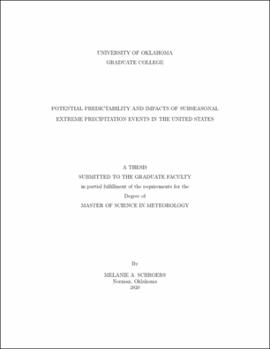| dc.description.abstract | Prediction of climate extremes at the S2S time scale has become a large topic of conversation between researchers and decision makers. Long duration precipitation events, lasting 14-days, may lead to devastating impacts in agriculture, transportation, infrastructure, water management and more. Yet, forecasting at this time scale lacks understanding, given that it is longer than typical weather forecasts (1-10 days) and shorter than seasonal forecasts (3+ months). Therefore, understanding the large scale features and predictability of S2S events is crucial. Most previous research focuses primarily on characteristics and impacts of short duration precipitation. In this study we investigated the variability and predictability of 14-day extreme precipitation events. Traditional methods to find variability, Principal Component Analysis (PCA) and Maximum Covariance Analysis (MCA), found large scale variability across all events, however these methods did not find unique patterns for our events. Therefore, composites of 500hPa geopotential height and precipitable water anomalous were used to investigate predictability. We found that the combination of these variables leads to better predictability but still resulted in many false alarm days, with low probability of detection. Thus, these synoptic patterns are not unique to S2S extreme events. Typical storm reports of these events were also surveyed to help analyze impacts. We found a large range of reports, from winter weather reports for West Coast events, to tropical storm reports in Southeast events. However, every region has a significant amount of flooding reports during our S2S events. Although there is still much to learn about S2S extreme precipitation events, this study contributes to the foundational knowledge of predictability and impacts to increase societal resilience to these high impact events. | en_US |
